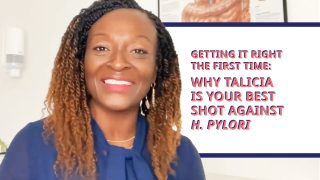Talicia: Simple, highly effective empiric therapy1,2
The branded H. pylori therapy most prescribed by gastroenterologists*
Talicia is listed as a First-line H. Pylori Treatment Option by the American College of Gastroenterology (ACG)1
Empiric use supported by the latest ACG Clinical Guideline—antibiotic susceptibility testing not required1
As a low-dose rifabutin-based triple therapy, Talicia is recommended as a first-line option with no requirement for prior resistance testing1
H. pylori Eradication Rates
Talicia was proven as a highly effective first-line therapy2
The right first-line therapy choice can help your patients avoid the burden of cycling through multiple rounds of treatment1,3
*Total prescriptions for the period January-June 2024, IQVIA Xponent Data.
†PPI + amoxicillin.
Findings from the Talicia phase 3 pivotal study in 455 treatment-naïve subjects with confirmed H. pylori infection. Eradication rates were 84% for Talicia in the all-patient population, also known as the intent-to-treat (ITT) population. Eradication rates were 90% for Talicia in the confirmed adherent population (mITT), which was a prespecified, protocol-defined population with confirmed blood levels of study drug at day 13 of the 14-day regimen.2
High rates of H. pylori eradication with Talicia2
Confirmed Adherent Patients
mITT Eradication Rate
All Patients
ITT Eradication Rate

Getting it right the first time: why Talicia is your best shot against H. pylori

The power of simplicity: why an all-in-one formulation can improve H. pylori treatment
Eradication Rates in Comorbid Patients
Effective in patients who closely represent today’s
H. pylori population4,5
Pooled post hoc analysis of phase 3 data showed Talicia eradication rates were not significantly affected by BMI status4
H. pylori mITT eradication rate
Active comparator included 1000 mg amoxicillin and 40 mg omeprazole, given Q8H with food for 14 days.
Talicia maintains high H. pylori eradication rates and a favorable safety profile in patients with Type 2 diabetes (T2DM), similar to the All-Patient (ITT) population5
- A pooled post hoc analysis of phase 3 data showed Talicia eradication rates were not significantly affected by diabetic status (91.7% T2DM vs 84.1% non-T2DM; P=0.1745)
- For patients with T2DM, H. pylori eradication failure and drug-drug interactions are significant concerns with clarithromycin triple therapy
- Talicia is safe and highly effective regardless of Type 2 diabetic status
References: 1. Chey WD, Howden CW, Moss SF, et al. ACG Clinical Guideline: treatment of Helicobacter pylori infection. Am J Gastroenterol. 2024;112(9):1730-1753. 2. Graham DY, Canaan Y, Maher J, Wiener G, Hulten KG, Kalfus IN. Rifabutin-based triple therapy (RHB-105) for Helicobacter pylori eradication: a double-blind, randomized, controlled trial. Ann Intern Med. 2020;172(12):795-802. 3. Moss SF, Shah SC, Tan MC, El-Serag HB. Evolving concepts in Helicobacter pylori management. Gastroenterology. 2024;166(2):267-283. 4. Kao JY, Almenoff JS, Portenier DD, Sheldon KS. Helicobacter pylori by low-dose rifabutin triple therapy (RHB-105) is unaffected by high body mass index. GastroHep. 2021;3:426-434. 5. Portenier D, Howden CW, Shah SC, et al. Low-dose rifabutin triple therapy for H. pylori is efficacious in patients with obesity and diabetes. Poster presented at Obesity Week Conference. November 2022. San Diego, CA.